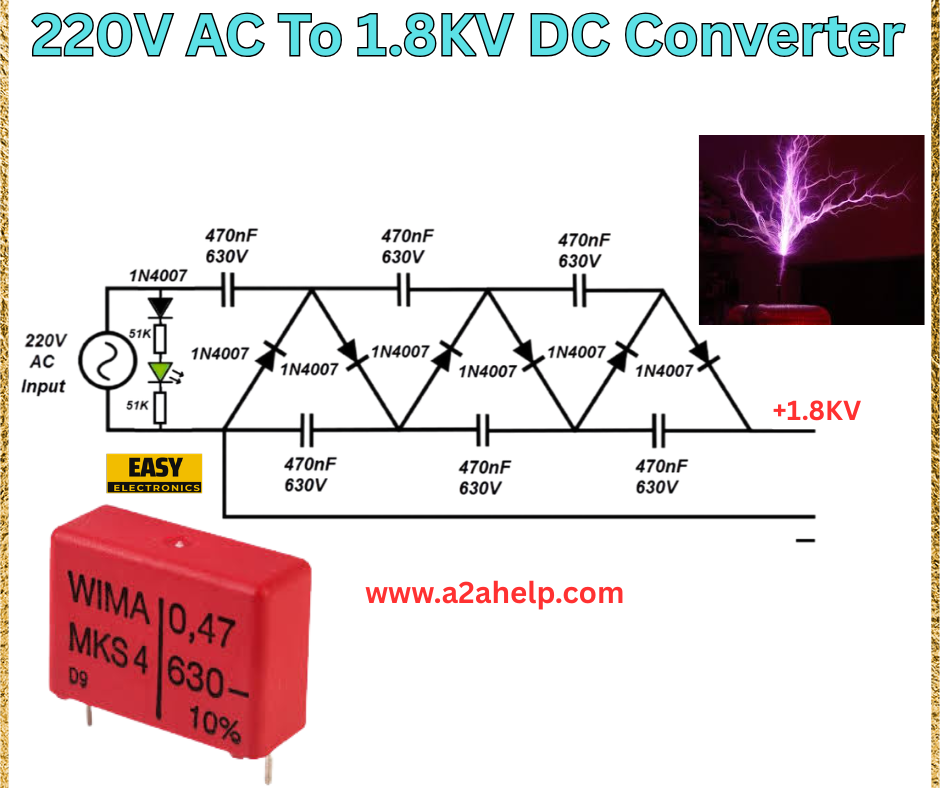In the world of electronics, converting alternating current (AC) to direct current (DC) at high voltages is a fascinating and essential process. One such innovative circuit is the 220V AC to 1.8kV DC Converter, which is widely used in various applications, from high-voltage experiments to specialized electronic devices. In this article, we’ll dive deep into how this converter works, its components, and its practical uses. Whether you’re an electronics enthusiast or a professional engineer, this guide will provide valuable insights to help you understand and optimize your projects.
Understanding the 220V AC to 1.8kV DC Converter
The 220V AC to 1.8kV DC Converter is designed to step up a standard 220V AC input to a staggering 1.8kV DC output. This high-voltage conversion is achieved through a combination of diodes, capacitors, and resistors, arranged in a voltage multiplier circuit. Such converters are compact, efficient, and ideal for applications requiring high DC voltage from a standard AC power source.
Key Components of the Circuit
- Diodes (1N4007): These are high-voltage rectifier diodes that play a crucial role in converting AC to DC. The 1N4007 diodes are arranged in a multiplier configuration to boost the voltage step-by-step.
- Capacitors (470nF, 630V and 0.47µF, 630V): Capacitors store and release electrical energy, smoothing the output and contributing to the voltage multiplication process. The WIMA MKS4 capacitor (0.47µF, 630V) is a high-quality component known for its reliability.
- Resistors (51kΩ): These limit the current and protect the circuit from overloads, ensuring safe operation.
- Input (220V AC): The standard input voltage that powers the circuit.

How the Circuit Works
The converter operates using a voltage multiplier design, often a Cockcroft-Walton multiplier or a similar configuration. Here’s a simplified breakdown of the process:
- Rectification: The 220V AC input is first rectified by the diodes, converting it into pulsating DC.
- Voltage Multiplication: The capacitors and diodes work together in stages to multiply the voltage. Each stage adds to the previous one, progressively increasing the output voltage.
- Smoothing: Additional capacitors filter the output, providing a stable 1.8kV DC voltage.
The circuit in the image shows multiple stages, with each stage consisting of a diode-capacitor pair. This step-up process ensures the final output reaches 1.8kV, making it suitable for high-voltage applications.
Applications of the 220V AC to 1.8kV DC Converter
This converter is versatile and finds use in various fields:
- High-Voltage Experiments: Ideal for educational labs or hobbyist projects involving electrostatics or plasma generation.
- Electronic Devices: Used in devices requiring high DC voltage, such as cathode ray tubes or ion generators.
- Industrial Uses: Applied in specialized equipment where high-voltage DC power is needed.
Benefits of Using This Converter
- Efficiency: The voltage multiplier design minimizes energy loss, making it highly efficient.
- Compact Size: Despite its high output, the circuit is relatively small and easy to integrate.
- Cost-Effective: Uses readily available components like the 1N4007 diodes and WIMA capacitors, keeping costs low.
Safety Tips for Handling High-Voltage Converters
Working with a 1.8kV DC output requires caution. Here are some safety tips:
- Always use insulated tools and wear protective gear.
- Ensure proper grounding to avoid electrical shocks.
- Test the circuit in a controlled environment to prevent damage or injury.
Where to Learn More
For detailed schematics and additional resources, visit www.a2ahelp.com, a trusted source for electronics tutorials and guides. The site offers step-by-step instructions and component details to help you build and troubleshoot your converter.
Conclusion
The 220V AC to 1.8kV DC Converter is a remarkable example of how simple components can be combined to achieve high-voltage outputs. Whether you’re experimenting at home or designing industrial equipment, understanding this circuit can elevate your electronics skills. By following the outlined steps and safety measures, you can successfully implement this converter in your projects. Explore more at www.a2ahelp.com and start your journey into high-voltage electronics today!
